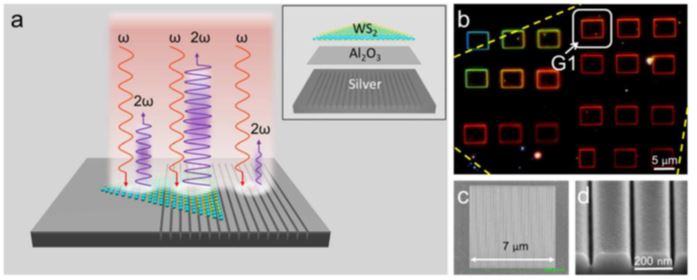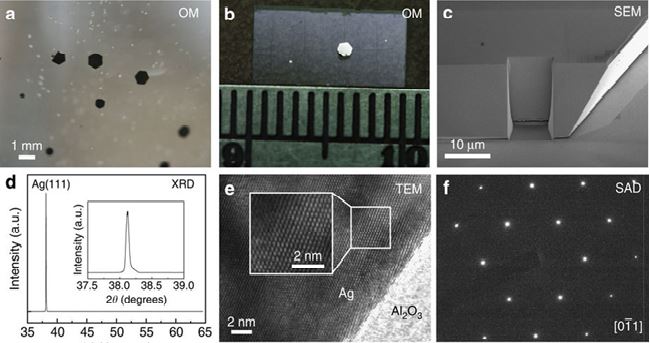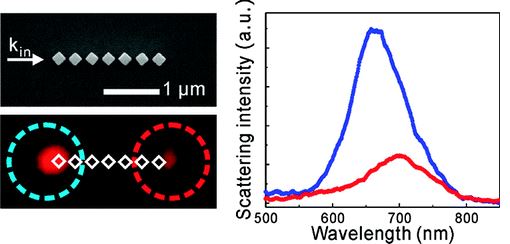- Research
- Plasmonic
Plasmonic
Chiral Second-Harmonic Generation from Monolayer WS2/Aluminum Plasmonic Vortex Metalens
Nano Lett. 20, 2857–2864 (2020)
Wan-Ping Guo, Wei-Yun Liang, Chang-Wei Cheng, Wei-Lin Wu, Yen-Ting Wang, Quan Sun, Shuai Zu, Hiroaki Misawa, Pi-Ju Cheng, Shu-Wei Chang, Hyeyoung Ahn*, Minn-Tsong Lin*, and Shangjr Gwo*

Two-dimensional spiral plasmonic structures have emerged as a versatile approach to generate near-field vortex fields with tunable topological charges. We demonstrate here a far-field approach to observe the chiral second-harmonic generation (SHG) at designated visible wavelengths from a single plasmonic vortex metalens. This metalens comprises an Archimedean spiral slit fabricated on atomically flat aluminum epitaxial film, which allows for precise tuning of plasmonic resonances and subsequent transfer of two-dimensional materials on top of the spiral slit. The nonlinear optical measurements show a giant SHG circular dichroism. Furthermore, we have achieved an enhanced chiral SHG conversion efficiency (about an order of magnitude greater than the bare aluminum lens) from monolayer tungsten disulfide (WS2)/aluminum metalens, which is designed at the C-exciton resonance of WS2. Since the C-exciton is not a valley exciton, the enhanced chiral SHG in this hybrid system originates from the plasmonic vortex field-enhanced SHG under the optical spin–orbit interaction.
Plasmonic enhancement and manipulation of optical nonlinearity in monolayer tungsten disulfide
Laser & Photonics Reviews 12, 1800188 (2018)
Jinwei Shi, Wei‐Yun Liang, Soniya S Raja, Yungang Sang, Xin‐Quan Zhang, Chun‐An Chen, Yanrong Wang, Xinyue Yang, Yi‐Hsien Lee, Hyeyoung Ahn, Shangjr Gwo

Monolayer transition metal dichalcogenides (TMDCs) have large second‐order optical nonlinearity owing to broken inversion symmetry in two‐dimensional (2D) crystals. However, despite the strong light–matter coupling in monolayer TMDCs, their nonlinear responses are ultimately limited by subnanometer thickness. Here, a dramatic enhancement of the second‐harmonic generation (SHG) is achieved from monolayer tungsten disulfide (WS2) incorporated onto a 2D silver (Ag) nanogroove grating with subwavelength pitch. By tuning surface plasmon mode and second‐harmonic frequency in resonance with the C exciton in WS2, a large SHG enhancement factor (≈400) and a large conversion efficiency (≈2.0 × 10–5) can be obtained. Furthermore, the azimuthal angle dependence of polarized SHG from monolayer WS2 can be manipulated by the nanogroove plasmonic mode. Based on this property, a polarization‐modulated optical encoding technique is demonstrated. The results suggest that 2D TMDC–plasmonic hybrid metasurface structures can provide an ideal integration platform for on‐chip nonlinear photonics and plasmonics.
Epitaxial aluminum-on-sapphire films as a plasmonic material platform for ultraviolet and full visible spectral regions
ACS Photonics 5, 7, 2624–2630 (2018)
Chang-Wei Cheng, Yun-Jhen Liao, Cheng-Yen Liu, Bao-Hsien Wu, Soniya S Raja, Chun-Yuan Wang, Xiaoqin Li, Chih-Kang Shih, Lih-Juann Chen, Shangjr Gwo

In comparison to noble metals (gold and silver), aluminum is a sustainable and widely applicable plasmonic material owing to its abundance in the Earth’s crust and compatibility with the complementary metal–oxide–semiconductor (CMOS) technology for integrated devices. Aluminum (Al) has a superior performance in the ultraviolet (UV) regime with the lowest material loss and good performance in the full visible regime. Furthermore, aluminum films can remain very stable in ambient environment due to the formation of surface native oxide (alumina) acting as a passivation layer. In this work, we develop an epitaxial growth technique for forming atomically smooth aluminum films on transparent c-plane (0001) sapphire (Al-on-Sapphire, ALOSA) by molecular-beam epitaxy (MBE). The MBE-grown ALOSA films have small plasmonic losses and enable us to fabricate and utilize high-quality plasmonic nanostructures in a variety of optical configurations (reflection, transmission, and scattering). Here, the surface roughness and crystal orientation of ALOSA films are characterized by atomic force microscopy (AFM) and X-ray diffraction (XRD). Moreover, the formation of smooth native oxide layer and abrupt heterointerfaces are investigated by transmission electron microscopy (TEM). We have also measured the optical dielectric function of epitaxial aluminum films by using spectroscopic ellipsometry (SE). These results show that the structural and optical properties of epitaxial aluminum films grown by MBE are excellent compared to polycrystalline aluminum films grown by other deposition methods. To illustrate the capability of device applications for the full visible spectrum, we demonstrate clear surface plasmon polarition (SPP) interference patterns using a series of double-groove surface interferometer structures with varied groove–groove separations under white-light illumination. Finally, we show the device performance of zinc oxide (ZnO) nanowire (UV) and indium gallium nitride (InGaN) nanorod (blue and green) plasmonic lasers prepared by using the epitaxial Al films. The measured lasing thresholds are comparable with the best available data obtained on the Ag films. According to these result, we suggest that epitaxial ALOSA films are a versatile plasmonic material platform in the UV and full visible spectral regions.
Giant colloidal silver crystals for low-loss linear and nonlinear plasmonics
Nature Communications 6, 7734 (2015)
Chun-Yuan Wang, Hung-Ying Chen, Liuyang Sun, Wei-Liang Chen, Yu-Ming Chang, Hyeyoung Ahn, Xiaoqin Li & Shangjr Gwo

The development of ultrasmooth, macroscopic-sized silver (Ag) crystals exhibiting reduced losses is critical to fully characterize the ultimate performance of Ag as a plasmonic material, and to enable cascaded and integrated plasmonic devices. Here we demonstrate the growth of single-crystal Ag plates with millimetre lateral sizes for linear and nonlinear plasmonic applications. Using these Ag crystals, surface plasmon polariton propagation lengths beyond 100 μm in the red wavelength region are measured. These lengths exceed the predicted values using the widely cited Johnson and Christy data. Furthermore, they allow the fabrication of highly reproducible plasmonic nanostructures by focused ion beam milling. We have designed and fabricated double-resonant nanogroove arrays using these crystals for spatially uniform and spectrally tunable second-harmonic generation. In conventional ‘hot-spot’-based nonlinear processes such as surface-enhanced Raman scattering and second-harmonic generation, strong enhancement can only occur in random, localized regions. In contrast, our approach enables uniform nonlinear signal generation over a large area.
All-Color Plasmonic Nanolasers with Ultralow Thresholds: Autotuning Mechanism for Single-Mode Lasing
Nano Lett., 14 (8), pp 4381–4388 (2014)
Yu-Jung Lu, Chun-Yuan Wang, Jisun Kim, Hung-Ying Chen, Ming-Yen Lu, Yen-Chun Chen, Wen-Hao Chang, Lih-Juann Chen, Mark I. Stockman, Chih-Kang Shih, and Shangjr Gwo*

We report on the first demonstration of broadband tunable, single-mode plasmonic nanolasers (spasers) emitting in the full visible spectrum. These nanolasers are based on a single metal–oxide–semiconductor nanostructure platform comprising of InGaN/GaN semiconductor nanorods supported on an Al2O3-capped epitaxial Ag film. In particular, all-color lasing in subdiffraction plasmonic resonators is achieved via a novel mechanism based on a property of weak size dependence inherent in spasers. Moreover, we have successfully reduced the continuous-wave (CW) lasing thresholds to ultrasmall values for all three primary colors and have clearly demonstrated the possibility of “thresholdless” lasing for the blue plasmonic nanolaser.
Plasmonic Nanolaser Using Epitaxially Grown Silver Film
Science, vol. 337 no. 6093 pp. 450-453 (2012)
Yu-Jung Lu1, Jisun Kim2, Hung-Ying Chen, Chihhui Wu, Nima Dabidian, Charlotte E. Sanders, Chun-Yuan Wang, Ming-Yen Lu, Bo-Hong Li, Xianggang Qiu, Wen-Hao Chang, Lih-Juann Chen, Gennady Shvets, Chih-Kang Shih, Shangjr Gwo

A nanolaser is a key component for on-chip optical communications and computing systems. Here, we report on the low-threshold, continuous-wave operation of a subdiffraction nanolaser based on surface plasmon amplification by stimulated emission of radiation. The plasmonic nanocavity is formed between an atomically smooth epitaxial silver film and a single optically pumped nanorod consisting of an epitaxial gallium nitride shell and an indium gallium nitride core acting as gain medium. The atomic smoothness of the metallic film is crucial for reducing the modal volume and plasmonic losses. Bimodal lasing with similar pumping thresholds was experimentally observed, and polarization properties of the two modes were used to unambiguously identify them with theoretically predicted modes. The all-epitaxial approach opens a scalable platform for low-loss, active nanoplasmonics.
Layer-by-Layer Assembly of Three-Dimensional Colloidal
Supercrystals with Tunable Plasmonic Properties
J. Am. Chem. Soc. 132, pp. 11259–11263 (2010)
Meng-Hsien Lin, Hung-Ying Chen, and Shangjr Gwo

We present a simple and efficient method for synthesizing large-area (>1 cm2), three-dimensional (3D) gold and silver nanoparticle supercrystal films. In this approach, Janus nanoparticle (top face solvent-phobic and bottom face solvent-philic) films with an arbitrary number of close-packed nanoparticle monolayers can be formed using layer-by-layer (LbL) assembly from suspensions of thiolate-passivated gold or silver colloids. Furthermore, we demonstrate that these films can act as true 3D plasmonic crystals with strong transverse (intralayer) and longitudinal (interlayer) near-field coupling. In contrast to conventional polyelectrolyte-mediated LbL assembly processes, this approach allows multiple longitudinal coupling modes with a conspicuous spectral dependence on the layer number. We have found a universal scaling relation between the spectral position of the reflectance dips related to the longitudinal modes and the layer number. This relation can be understood in terms of the presence of a plasmonic Fabry−Pérot nanocavity along the longitudinal direction that allows the formation of standing plasmon waves under plasmon resonance conditions. The realization of 3D plasmonic coupling enables broadband tuning of the collective plasmon response over a wide spectral range (visible and near-IR) and provides a pathway to designer plasmonic metamaterials.
Far-Field Optical Imaging of a Linear Array of Coupled Gold Nanocubes: Direct Visualization of Dark Plasmon Propagating Modes
ACS Nano 5, pp 8223–8229 (2011)
Hung-Ying Chen, Chieh-Lun He, Chun-Yuan Wang, Meng-Hsien Lin, Daisuke Mitsui, Miharu Eguchi, Toshiharu Teranishi, and Shangjr Gwo

Plasmonic nanoantenna arrays hold great promise for diffraction-unlimited light localization, confinement, and transport. Here, we report on linear plasmonic nanoantenna arrays composed of colloidal gold nanocubes precisely assembled using a nanomanipulation technique. In particular, we show the direct evidence of dark propagating modes in the plasmon coupling regime, allowing for transport of guided plasmon waves without far-field radiation losses. Additionally, we demonstrate the possibility of plasmon dispersion engineering in coupled gold nanocube chains. By assembling a nanocube chain with two sections of coupled nanocubes of different intercube separations, we are able to produce the effect of a band-pass nanofilter.
Surface-Plasmon-Mediated Photoluminescence Enhancement from Red-Emitting InGaN Coupled with Colloidal Gold Nanocrystals
J. Phys. Chem. C 114, pp. 12987–12993 (2010)
Chen-Ying Wu, Chieh-Lun He, Hong-Mao Lee, Hung-Ying Chen and Shangjr Gwo

We utilized colloidal gold nanocrystals of different shapes (triangular and hexagonal plates, nanorods, and nanoparticles), a self-assembled gold nanoparticle superlattice, and a sputtered gold film to investigate the plasmon-coupling effects on the photoluminescence (PL) from a red-emitting InGaN film. We observed a strong local enhancement (about 1 order of magnitude) of PL intensity at the gold nanocrystal plate covered regions on the InGaN film. In addition, PL intensity spatial distributions were observed for both gold triangular and hexagonal plates deposited on the InGaN film. The acquired distributions could be used to map the plasmonic local density of states on individual nanocrystal plates in the far-field. Furthermore, by comparing scattering and extinction spectra of various gold nanostructures, a self-assembled gold nanoparticle superlattice, and sputtered gold film with the PL spectra in the corresponding InGaN−gold hybrid systems, we have found a consistent occurrence of luminescence enhancement or quenching, depending on the outcoupling efficiency of plasmons into photons in the far-field.
Plasmon Hybridization in Individual Gold Nanocrystal Dimers: Direct Observation of Bright and Dark Modes
Nano Lett. 10, pp. 632–637 (2010)
S.-C. Yang, H. Kobori, C.-L. He, M.-H. Lin, H.-Y. Chen, C. Li,M. Kanehara, T. Teranishi, and S. Gwo

We apply a nanomanipulation technique to assemble pairs of monodispersed octahedral gold nanocrystals (side length, 150 nm) along their major axes with a varying tip-to-tip separation (25−125 nm). These pairs are immobilized onto indium tin oxide coated silica substrates and studied as plasmonic dimers by polarization-selective total internal reflection (TIR) microscopy and spectroscopy. We confirm that the plasmon coupling modes with the scattering polarization along the incident light direction result from the transverse-magnetic-polarized incident light, which induces two near-field-coupled dipole moments oriented normal to the air−substrate interface. In such cases, both in-phase (antibonding) and antiphase (bonding) plasmon coupling modes can be directly observed with the incident light wave vector perpendicular and parallel to the dimer axis, respectively. The observation of antiphase plasmon coupling modes (“dark” plasmons) is made possible by the unique polarization nature of the TIR-generated evanescent field. Furthermore, with decreasing nanocrystal separation, the plasmon coupling modes shift to shorter wavelengths for the incident light perpendicular to the dimer axis, whereas relatively large red shifts of the plasmonic coupling modes are found for the parallel incident light.